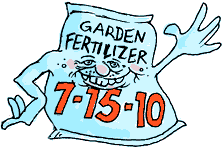Fertilizer
Always check the ingredients listed on any bag of fertilizer you intend to buy. If the label says it contains sewage sludge or leather meal do not use it in your vegetable garden because it may contain heavy metals which are not good to eat.

- When you look at a bag of fertilizer the label will have 3 numbers printed on the bag. They represent the combination of nitrogen, phosphorus and potassium in the fertilizer.
- Each number represents how many parts of each element is mixed in to produce the type of fertilizer in the bag.
- Read the instruction label carefully. It will tell you when, how and on which plants it should be used.
- If you aren’t sure, just ask the salesperson who works in the garden store before you purchase any chemicals. They will be happy to help you chose the right blend for your plants.
Nitrogen
- Nitrogen helps plants grow faster but too much of it will burn the roots and prevent flowering.
- Too little nitrogen will make green leaves turn a lighter shade and cause the older leaves to turn yellow.
- The best type of nitrogen-rich fertilizer should have Slow Release Formula printed on the bag label. It dissolves slowly so the plants don’t get too much nitrogen at once.
- If you can use organic matter like compost instead of purchased fertilizer you will still provide your plants with all the nitrogen they need and you won’t be using chemicals.
Phosphorus
- Phosphorus helps plants form new roots, develop seeds, fruits, and flowers. It also increases a plant's ability to resist diseases.
- Plants that aren't getting enough phosphorus will have darker old leaves or develop a reddish color.
- The plant will start to produce poorer flowers and fruit when the soil needs more phosphorus.
- Phosphorus should be added to the soil when you are tilling because it tends to stay put in one spot.
Potassium
- Potassium helps increase a plant's disease resistance, strengthen the stems, and maintain vigorous growth.
- Too little potassium will show up as a general slowing of growth and leaves that are smaller than usual.
- Potassium mixed into fertilizer will give plants the boost they need.
Fertilizing Seedlings
- When your seedling's second set of leaves, called true leaves, have unfurled, you can fertilize your new plants.
- Purchase Concentrated Water Soluble Fertilizer specially made for seedlings. The fertilizer should have the numbers 10-52-10 or 10-30-10 on the label.
- Ask an adult to help you prepare the fertilizer. The directions usually require ½ tsp (2.5 mL) of fertilizer to 4 cups (1 L) of water, but this mixture is too strong for seedlings and will burn them.
- Mix just ¼ tsp (1.25 mL) with 8 cups (2 L) of water in a clean bottle that has a lid.

- Keep all bottles of the fertilizer mixture tightly capped and label them well with a permanent marker. You wouldn't want anyone to drink it because it is toxic.
caring
showing
|



